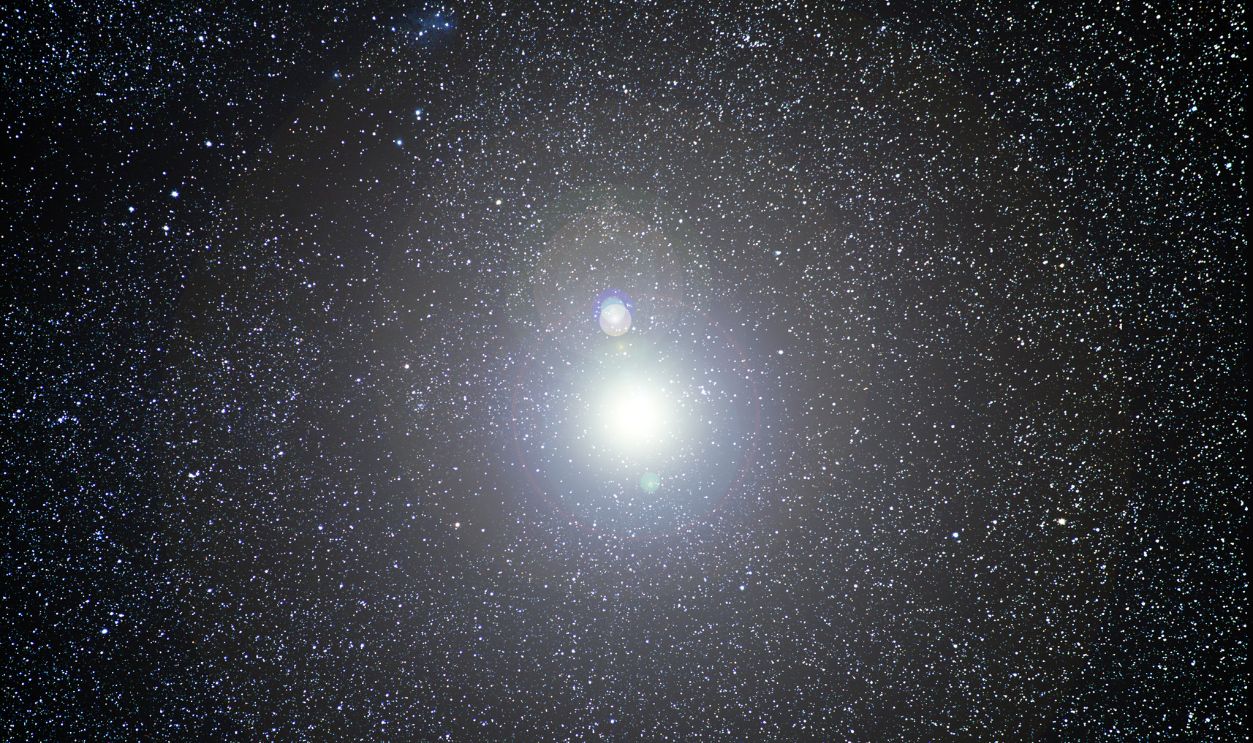How Antarctica's Ice Reveals Cosmic Mysteries
The IceCube Observatory is a scientific miracle built to reveal some of the universe’s most well-kept secrets. What can its ghostly blue light tell us about the origins of the cosmos?

Telescopes Come In All Shapes And Sizes
When people hear the word telescope, they think of the medieval ones used by Galileo Galilei or the massive ones set up on top of mountains. But a few would imagine that one of the world’s most significant telescopes is actually located under the icy surface of the South Pole.
 Amble, CC BY-SA 3.0, Wikimedia Commons
Amble, CC BY-SA 3.0, Wikimedia Commons
But The IceCube Observatory Is Different
The IceCube Neutrino Observatory is buried deep beneath the Antarctic ice. Unlike traditional telescopes that capture light, radio waves, or other forms of electromagnetic radiation, IceCube specializes in detecting neutrinos—mysterious subatomic particles. Using sensors, it uses the pristine, transparent ice to catch fleeting signals of these elusive particles.
 Cmichel67, CC BY-SA 4.0, Wikimedia Commons
Cmichel67, CC BY-SA 4.0, Wikimedia Commons
It Detects Ghost Particles
Neutrinos are often referred to as the "ghost particles" because they can pass through matter almost undetected. They are born in the most extreme environments, like supernovae or the fusion processes within our sun. By burying sensors deep in the ice, IceCube avoids interference from cosmic rays.
 Karen Andeen and Matthias Plum, CC BY 4.0, Wikimedia Commons
Karen Andeen and Matthias Plum, CC BY 4.0, Wikimedia Commons
Nature’s Most Elusive Creation
Despite their abundance, neutrinos rarely interact with other particles and this makes their detection incredibly challenging. IceCube offers a unique window into this hidden world by allowing scientists to study these enigmatic particles and solve mysteries about the origins and evolution of the universe.
 Alexrk2, CC BY-SA 3.0, Wikimedia Commons
Alexrk2, CC BY-SA 3.0, Wikimedia Commons
But Why Antarctica?
Antarctica might seem like an improbable location for one of the world's most advanced observatories, but it is uniquely suited for IceCube's mission. The continent's vast ice sheet is exceptionally clear and stable to provide the perfect medium to study neutrinos.
 NASA/Joe MacGregor, Wikimedia Commons
NASA/Joe MacGregor, Wikimedia Commons
Isolation Is Actually Better
Additionally, the isolation minimizes human-made interference to ensure pristine conditions for capturing neutrino interactions. The extreme environment might pose a logistical challenge for transporting equipment and enduring harsh winters. However, these obstacles are outweighed by the unparalleled scientific opportunities.
 Heraldry, CC BY-SA 3.0, Wikimedia Commons
Heraldry, CC BY-SA 3.0, Wikimedia Commons
So, What Are These Ghostly Messengers Of The Universe?
Neutrinos are some of the universe's most fascinating yet enigmatic particles. They are fundamental subatomic particles with nearly no electric charge or mass, and this allows them to pass through matter almost entirely unimpeded. Trillions of neutrinos stream through your body every second, yet you remain unaware of their presence.
 Karen Andeen and Matthias Plum, CC BY 4.0, Wikimedia Commons
Karen Andeen and Matthias Plum, CC BY 4.0, Wikimedia Commons
They Can Provide Answers
Coming from nuclear reactions in the sun, exploding supernovae, active galactic nuclei, gamma-ray bursts, and black hole collisions, neutrinos carry invaluable information about these cataclysmic events. By tracing the origins of neutrinos, scientists can peek into the universe's most mysterious events.
 Argonne National Laboratory, Wikimedia Commons
Argonne National Laboratory, Wikimedia Commons
But They Are So Difficult To Detect
Detecting neutrinos is one of the most significant challenges in modern physics due to their elusive nature. Since neutrinos rarely interact with matter, they can pass through vast stretches of the universe without leaving a trace. It’s like looking for a needle in a haystack, but on a cosmic scale.
 Fred Ullrich, Wikimedia Commons
Fred Ullrich, Wikimedia Commons
This Is Where IceCube Comes In
To increase the odds, scientists use immense detectors like IceCube. It monitors the Antarctic ice for the faint signals produced when a neutrino occasionally collides with an atomic nucleus. Despite their abundance, only a minuscule fraction of neutrinos can be detected, which makes every captured event a scientific treasure.
 Taavi Adamberg, CC BY-SA 3.0, Wikimedia Commons
Taavi Adamberg, CC BY-SA 3.0, Wikimedia Commons
The Science Behind Neutrino Detection
When a neutrino hits an atomic nucleus in the ice, it creates charged particles that emit Cherenkov radiation—a type of blue light. This light is detected by IceCube’s thousands of Digital Optical Modules or DOMs. Newly created muons can exceed the speed of light while traveling through ice.
 Argonne National Laboratory, CC BY-SA 2.0,Wikimedia Commons
Argonne National Laboratory, CC BY-SA 2.0,Wikimedia Commons
We Thank The Muons
A muon is a charged particle that leaves a visible trail of Cherenkov radiation as it travels through the ice. By analyzing the patterns and timing of these light flashes, scientists can reconstruct the trajectory and energy of the neutrinos, tracing them back to their cosmic origins.
 Doanmontana, CC BY-SA 4.0, Wikimedia Commons
Doanmontana, CC BY-SA 4.0, Wikimedia Commons
Understanding The Sonic Boom Of Light
Cherenkov radiation is a fascinating phenomenon described as the optical equivalent of a sonic boom. It occurs when a charged particle, like a muon, travels through a medium such as ice faster than the speed of light in that medium.
 Melamed katz, CC BY-SA 3.0, Wikimedia Commons
Melamed katz, CC BY-SA 3.0, Wikimedia Commons
It’s Not An Anomaly
This isn’t to be confused with the speed of light in a vacuum. Cherenkov radiation provides a signal that reveals where and when a neutrino interaction occurred. By studying this light, scientists can piece together the story of a neutrino’s journey across the universe.
 ESA/Hubble, CC BY 4.0, Wikimedia Commons
ESA/Hubble, CC BY 4.0, Wikimedia Commons
But It Definitely Leaves Us Scratching Our Heads
To better understand the Cherenkov radiation, you need to know that it occurs when charged particles, such as electrons or muons, travel through a transparent medium—like water or ice. They don’t exceed the universal speed of light in a vacuum but rather the slower speed of light within the medium.
 University of Massachusetts, Lowell, Wikimedia Commons
University of Massachusetts, Lowell, Wikimedia Commons
With Its Blue Hue
As these particles pass through, they create a shockwave of electromagnetic radiation, which manifests as a distinctive blue light. This glow is caused by the particular wavelengths of light emitted, which fall within the blue end of the spectrum. The same light can be seen around underwater nuclear reactor cores.
 United States Nuclear Regulatory Commission, Wikimedia Commons
United States Nuclear Regulatory Commission, Wikimedia Commons
To Cause A “Blast”
To visualize Cherenkov radiation, it can be compared to a "sonic boom of light". Sound waves compress and overlap because the plane moves faster than they can propagate. Similarly, in Cherenkov radiation, light waves overlap and create a coherent wavefront of light because the particle outpaces the medium's light-speed threshold.
 Cmglee, CC BY-SA 4.0, Wikimedia Commons
Cmglee, CC BY-SA 4.0, Wikimedia Commons
Building A Telescope Wasn’t Easy
Instead of a traditional structure pointing toward the sky, IceCube’s “telescope” is buried deep within the Antarctic ice sheet. This involved drilling 86 vertical holes into the ice using hot water drills, each housing a string of Digital Optical Modules (DOMs).
 Cmichel67, CC BY-SA 4.0, Wikimedia Commons
Cmichel67, CC BY-SA 4.0, Wikimedia Commons
A Seven-Year Journey
Constructing the IceCube Observatory was a monumental task that spanned seven years, from 2004 to 2010. The process involved drilling 86 holes, each over 2,500 meters deep, into the Antarctic ice sheet using a custom-designed hot-water drill.
That Was Difficult To Achieve
The project faced numerous challenges, from logistical hurdles to the unpredictable Antarctic weather. Teams had to work during the brief summer months when temperatures were relatively manageable. Despite setbacks, the perseverance and ingenuity of the IceCube team brought the project to fruition.
 euphro, CC BY-SA 2.0, Wikimedia Commons
euphro, CC BY-SA 2.0, Wikimedia Commons
The Eyes Of IceCube
DOMs are the observatory’s essential components, acting as its “eyes” beneath the ice. Each DOM is a spherical device containing a photomultiplier tube (PMT) and sophisticated electronics capable of detecting and amplifying the faint Cherenkov radiation produced by neutrino interactions.
 Amble, CC BY-SA 3.0, Wikimedia Commons
Amble, CC BY-SA 3.0, Wikimedia Commons
DOMs Are Highly Sensitive
Capable of detecting single photons of light, the DOMs are strong enough to withstand the extreme conditions of the Antarctic ice. Linked by cables that transmit data to the surface, the DOMs work together to capture and analyze the fleeting signals of neutrinos, and this enables groundbreaking discoveries.
Hot Water Drilling Was The Only Solution
Scientists used an innovative drilling technique by relying on hot water to melt through the thick ice. The drill pumped heated water to create boreholes over 2.5 kilometers deep to place the DOMs in their precise locations. The extreme cold and remote environment made this a challenging task.
What About The Staff?
Life at the South Pole is as challenging and unique. Scientists working at IceCube endure freezing temperatures in winter and complete isolation during the polar night, which lasts six months. Despite these challenges, the IceCube team adapts to this environment with ingenuity and grit to form a close-knit community.
Collaboration And Ingenuity In Science
The human element is behind IceCube’s remarkable achievements: A global team of scientists, engineers, and support staff working together to achieve the extraordinary. Collaboration is key, as experts from various fields, including physics, engineering, logistics, and math, work together to solve complex problems.
They Live Under Extreme Conditions
Daily life involves meticulous planning to preserve equipment in extreme colds and maintain their physical and mental health in isolation. Yet, there’s a profound sense of purpose among the team, driven by the knowledge that their work contributes to unraveling some of the universe's greatest mysteries.
To Operate A State-Of-The-Art Observatory
Operating the IceCube Observatory requires innovative solutions to deal with the South Pole's harsh conditions. The extreme cold impacts machinery and electronics, and this necessitates unique designs for equipment like the DOMs. Maintenance is a challenge, with every task requiring preparation to avoid exposure to life-threatening temperatures.
But They Manage To Do It
The observatory operates year-round, with data constantly flowing from its sensors to researchers worldwide. During the winter months, when transport to and from the South Pole is impossible, the team relies on remote operations and reliable systems to keep IceCube functioning.
And Can Overcome Nature’s Challenges
Antarctic winters bring challenges that test even the most prepared teams. The complete darkness and isolation require meticulous planning and resilience. Supplies, tools, and essential equipment must be stocked before the winter months, as no planes can reach the station during this time.
IceCube Takes Data From Ice To The Universe
Each of the DOMs detects faint flashes of light from neutrino interactions and transmits this information to a central processing hub on the surface. Despite the challenges of operating in one of the most isolated places on Earth, IceCube’s data pipeline runs seamlessly, thanks to advanced computing systems.
And Filters Out Cosmic Ray Noise
Not all detected signals are caused by neutrinos. The Antarctic ice is constantly bombarded by cosmic rays, which also produce Cherenkov radiation and create background noise in IceCube’s data. Sophistic algorithms and machine learning techniques are employed to distinguish genuine neutrino interactions from these false positives.
 Unknown Author, CC BY-SA 3.0, Wikimedia Commons
Unknown Author, CC BY-SA 3.0, Wikimedia Commons
To Trace Neutrinos Back To Their Cosmic Origins
One of IceCube’s most impressive capabilities is its ability to trace detected neutrinos back to their sources in the cosmos. By reconstructing the trajectory of the particles from the Cherenkov radiation signals detected by the DOMs, scientists can identify the direction from which the neutrinos arrived.
 John Hardin, CC BY 4.0, Wikimedia Commons
John Hardin, CC BY 4.0, Wikimedia Commons
And Reveal The Universe’s Deepest Secret
This information is then cross-referenced with astronomical observations to locate cosmic phenomena such as supernovae or black holes that might have emitted the neutrinos. By mapping neutrino origins, IceCube has revolutionized our understanding of extreme cosmic events that are otherwise impossible to understand.
 Pablo Carlos Budassi, CC BY-SA 4.0, Wikimedia Commons
Pablo Carlos Budassi, CC BY-SA 4.0, Wikimedia Commons
Real-Time Alerts For Astronomical Observatories
IceCube also provides real-time alerts to the global scientific community. When a high-energy neutrino is detected, it rapidly calculates its trajectory and shares this information with telescopes and observatories worldwide. These alerts enable astronomers to quickly focus their instruments on potential sources of the neutrino.
The Breakthrough Of 2017
In 2017, IceCube achieved a historic milestone by tracing a neutrino back to its source: A blazar—an active galactic nucleus powered by a supermassive black hole. It was the first time a neutrino’s origin had been identified and confirmed blazars are cosmic accelerators capable of producing high-energy cosmic rays.
 NASA and The Hubble Heritage Team (STScI/AURA), Wikimedia Commons
NASA and The Hubble Heritage Team (STScI/AURA), Wikimedia Commons
IceCube’s Role In Multi-Messenger Astronomy
IceCube has become a pivotal player in multi-messenger astronomy. This is a field that combines observations of various cosmic messengers, such as gravitational waves and neutrinos. By detecting neutrinos and sharing real-time alerts, IceCube collaborates with telescopes and detectors worldwide to study cosmic events from multiple angles.
A New Era In Science
Traditionally, astronomy has relied on different types of light to study the universe. This allows scientists to peer into regions of the universe that light can’t penetrate, such as the dense cores of supernovae or the immediate vicinity of black holes, to usher in a new era of scientific discovery.
Leading To Broader Implications
Such groundbreaking ability is a gateway to answering some of the most profound questions in physics and astronomy. Neutrinos, due to their unique properties, provide a new perspective on the universe, and IceCube contributes to a holistic view of the cosmos.
 MissMJ, Cush, afgeleid werk, CC0, Wikimedia Commons
MissMJ, Cush, afgeleid werk, CC0, Wikimedia Commons
Like The Understanding Of Dark Matter
Dark matter, an enigmatic substance that makes up almost 85% of the universe’s matter, remains one of the greatest mysteries in modern science. While neutrinos themselves are not dark matter, their interactions—or lack thereof—with visible matter and forces help scientists test theories about dark matter's behavior and properties.
 ESA/Hubble, CC BY 4.0, Wikimedia Commons
ESA/Hubble, CC BY 4.0, Wikimedia Commons
And Testing Fundamental Physics In Extreme Cosmic Conditions
Neutrinos are born in some of the universe's most extreme environments. These cosmic laboratories present conditions far beyond what can be recreated on Earth. By studying neutrinos from these sources, IceCube allows scientists to test fundamental physics under immense energy and gravity conditions.
 Usman, S., Jocher, G., Dye, S. et al., CC BY 4.0, Wikimedia Commons
Usman, S., Jocher, G., Dye, S. et al., CC BY 4.0, Wikimedia Commons
To Understand How Our Universe Was Shaped
Scientists can test the limits of the Standard Model of particle physics and explore neutrino oscillations and how they change when traveling. Moreover, they can investigate possible deviations from established physical laws. Thanks to IceCube, we can challenge and refine our understanding of physics.
 ablo Carlos Budassi, CC BY-SA 4.0, Wikimedia Commons
ablo Carlos Budassi, CC BY-SA 4.0, Wikimedia Commons
And The Mysteries Of Supernovae And Neutron Stars
Supernovae and neutron stars are some of the most fascinating phenomena in the universe. Neutrinos play a significant role in these events. During a supernova or neutron star explosion, neutrinos carry away the majority of the energy to provide a detailed snapshot of the collapse and explosion processes.
In Addition To High-Energy Physics
IceCube is at the forefront of high-energy physics by pushing the limits of what is known about particles and forces. By detecting neutrinos with energies far exceeding those produced by Earth-based accelerators, IceCube provides insights into phenomena that can’t be studied in laboratories.
 R.J. Hall. Redrawn, CC BY-SA 3.0, Wikimedia Commons
R.J. Hall. Redrawn, CC BY-SA 3.0, Wikimedia Commons
What Lies Ahead
With the planned expansion of the IceCube Observatory, the discovery potential is immense. Scientists hope to detect neutrinos from yet-to-be-observed sources. As technology advances, the ability to pinpoint neutrinos’ sources with greater accuracy will lead to even more profound insights.






















